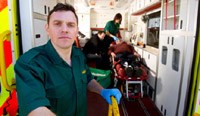
Top stories


LegalCape Town estate agent dupes seller in elaborate property scam, court intervenes
Anelisa Zungu and Renel Fourie 17 hours




More news




Fewer than 10% of heart attack patients transferred from their initial hospital to one offering the life-saving procedure are transferred within the recommended 30 minutes, according to the researchers, who published their findings in the 28 November issue of Archives of Internal Medicine.
For ST-segment elevation myocardial infarction (STEMI) patients, quick response is critical because this type of heart attack is caused by a complete blockage of blood supply to the heart. Angioplasty should be performed as quickly as possible, but many smaller hospitals do not have the staff or facilities to perform the procedure around the clock. Experts agree that the hospitals should send those patients on to a hospital that offers the procedure. The guidelines recommend that the time from arrival at the first hospital until the patient leaves should be no more than 30 minutes.
"This represents a large and avoidable increase in risk of death for these patients," said lead author Jeph Herrin, assistant adjunct professor of cardiology at Yale School of Medicine. "Numerous studies have shown that even a few minutes delay in receiving angioplasty increases the risk of death for STEMI patients. Among this group are thousands of patients that are delayed more than an hour from what is recommended."
Herrin and co-authors analyzed nationwide data collected by the Centers for Medicare & Medicaid Services on all heart attack patients with STEMI who were transferred explicitly for angioplasty during 2009. This included patients who were not covered by Medicare, though patients were not included if the hospital did not transfer at least five patients.
In 2009, nearly 14000 heart attack patients were transferred from smaller hospitals to hospitals that offer angioplasty, but fewer than 10 percent of them were sent onto the second hospital within the recommended time. Nearly one third of the heart attack patients were sent more than 90 minutes after arriving at the emergency room.
"We have made such great strides in reducing the time to treatment for those patients who are admitted to hospitals with angioplasty facilities; our next big challenge is to be sure that we reduce delays for patients who are transferred," said senior author Harlan Krumholz, M.D., the Harold H. Hines Jr. Professor of Medicine (Cardiology) at Yale School of Medicine.
Other authors on the study include Lauren E. Miller, Dima F. Turkmani, Wato Nsa, Elizabeth E. Drye, M.D., Susannah M. Bernheim, M.D., Shari M. Ling, M.D., Michael T. Rapp, M.D., Lein F Han, Dale Bratzler, M.D., Elizabeth H. Bradley, Brahmajee K. Nallamothu, M.D., and Henry H. Ting, M.D.
The Centers for Medicare & Medicaid Services funded the study.